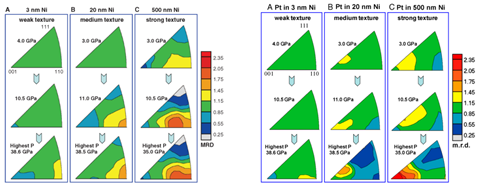Detecting Grain Rotation at the Nanoscale - Dr. Bin Chen
Controlling the texture of materials is a crucial element in improving the strength and in extending the lifetime of materials. Plastic deformation of coarse grained (> 100 nm) metals has been well-described as a process in which the application of shear stress causes crystallites to rotate within the lattice structure until they achieve a preferred texture. It has proven challenging to determine if the same process occurs in nanomaterials due to the challenges associated with observing the rotation of ultrafine crystals. As reported in the March 4 issue of PNAS [PNAS 111 3350 ( 2014)], an international team of scientists from six different institutions have now succeeded in observing nanoscale plastic deformation by collecting x-ray diffraction (XRD) on polycrystalline metal samples under high pressure in a radial diamond anvil cell (rDAC). For the series of experiments, the samples consisted of spherical platinum particles (~1 μm) within a medium of spherical nickel particles (500 nm, 20 nm, or 3 nm). According to Bin Chen, lead author and director of the Shanghai Laboratory of HPSTAR (Center for High Pressure and Technology Advanced Research), “We chose platinum and nickel, because both have fcc structures, and both are relatively easy for performing texture analysis. We also had several sizes of nickel to work with.” Much to the surprise of the research team, the texture strength of platinum dropped significantly as the particle size of the nickel media was reduced, even though the same sized platinum particles were used throughout the experiments.

The inverse pole figures of nickel with different particle size (left) and bulk-sized platinum in differently sized nickel media (right).
Texture was obvious when 500-nm nickel was used, but a considerable loss in texture was observed with the 20-nm nickel. With 3-nm nickel, almost all of the texture disappears. One possible theory was a lack of sufficient shear stress, but this was ruled out both mathematically and by the observation of curved diffraction lines. Once the first theory was excluded, said the researchers, it became obvious that an enhanced grain rotation of the large platinum particles within the finer nickel medium caused the reduction in texture. The dislocation of particles under high pressure is an attempt to minimize system energy and to establish equilibria between neighboring grains. A mixture of coarse grains thus requires high energy and torque to rotate the particles, and rotation occurs at a slow rate. However, for a system with fine particles, dislocation has little to do with equilibrating the system. Instead, grain rotation is the system’s attempt to minimize the increase in compression induced energy, which results in a high rotation rate of the fine particles and a loss in texture of the coarse particles. Chen said, “The degree of grain rotation in other metals may be different, but the observed size-dependence of grain rotation should be similar. Since this report was qualitative, our future plans are to directly measure the degree of rotation of the nanocrystals.”
By Anthony S. Stender, MRS BULLETIN, 39, 391 (2014).
Link to the paper published on PNAS:
http://www.pnas.org/content/111/9/3350.short
